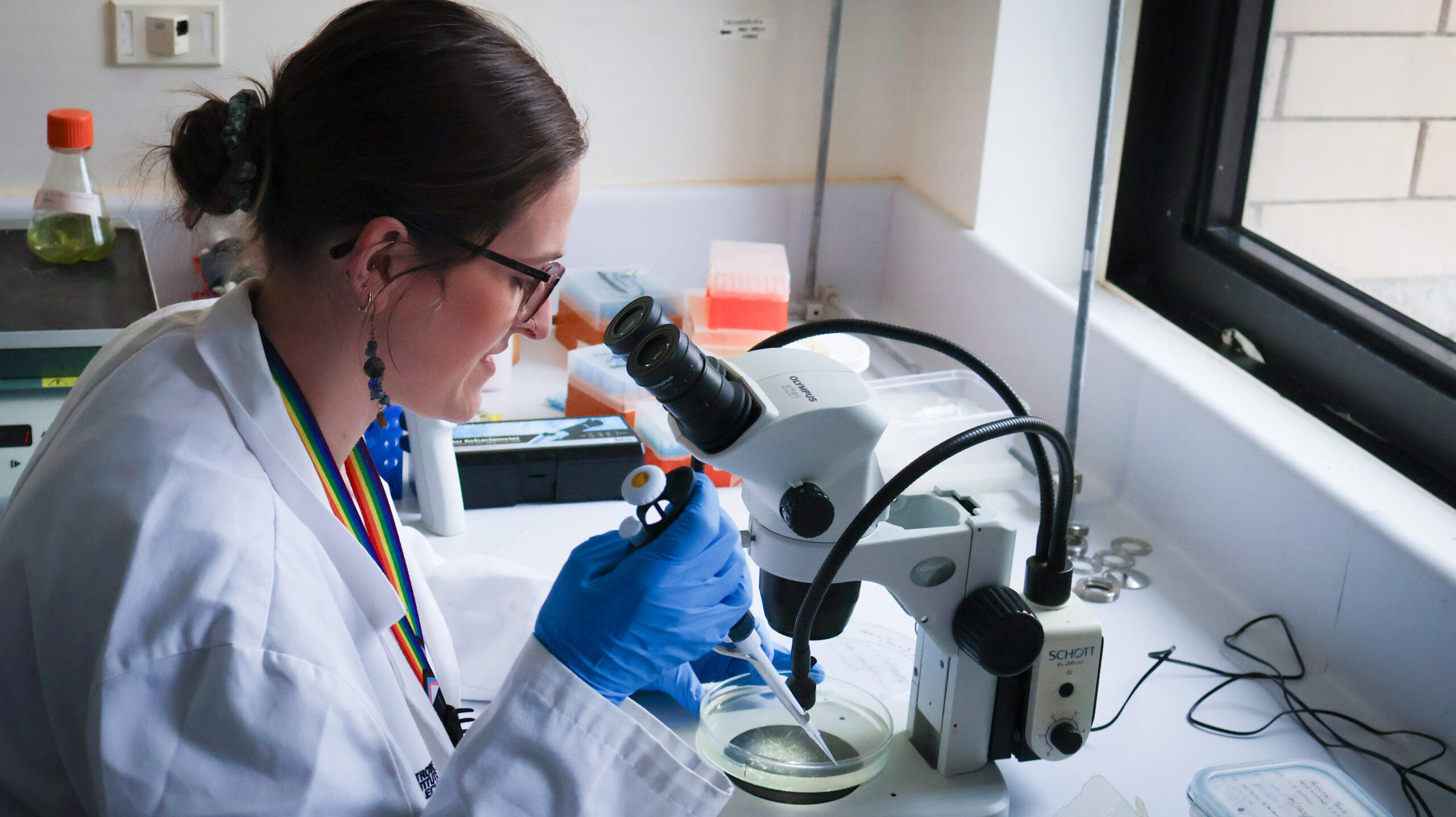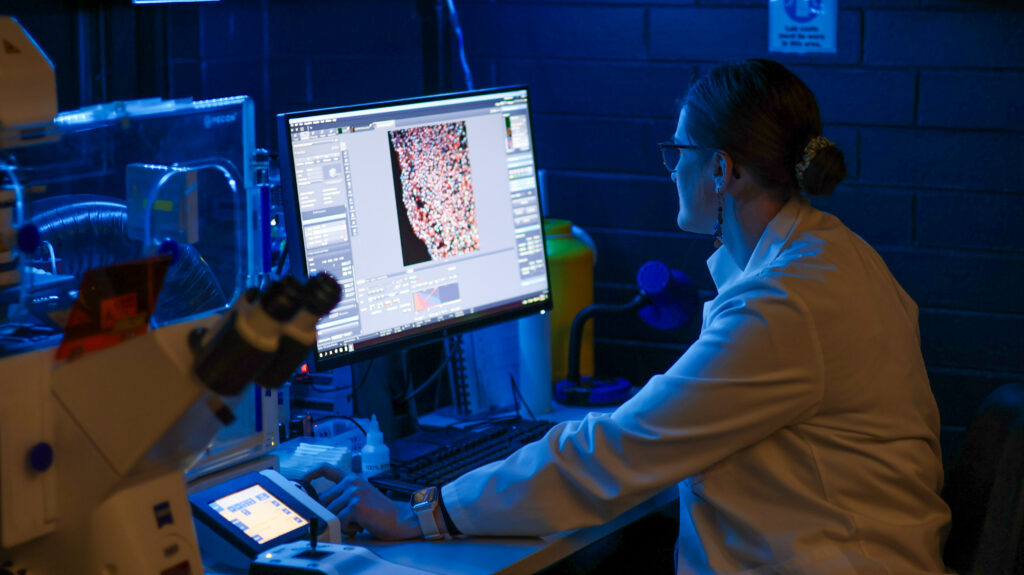Research Spotlights
AINSE Pathway scholar Jennifer Tinker is uncovering the secrets of Trichoplax adhaerens—an ancient, radiation-resistant marine organism—and what its resilience could mean for future advancements in human health, space exploration, and cancer biology. Jennifer’s Honours research, conducted in collaboration with La Trobe University and ANSTO, investigates how Trichoplax adhaerens—one of the …
By Georgia Barrington-Smith Beneath abandoned mine sites, a silent chemical threat lingers. When sulfide-rich rocks are exposed to air and water during mining, they trigger acid mine drainage—acidic runoff that releases toxic elements like arsenic (As) and antimony (Sb) into surrounding soil and water.This contamination can persist for decades after …
By Georgia Barrington-Smith Have you ever wondered what the main risks of space travel are? Hollywood films like The Martian and Apollo 13 often portray the dramatic risks of space travel, such as mechanical failures, life support issues, and unpredictable space weather. However, as astronauts journey far from home, venturing …
By Georgia Barrington-Smith In the quest to unravel one of life’s greatest mysteries—how it all began—scientists are looking beyond our planet, to the vastness of space, in search of the molecular seeds that might have sown life on Earth. One key stop on that journey is Titan—Saturn’s largest moon. For …
By Georgia Barrington-Smith In today’s digital era, the rapid proliferation of online services and cloud computing has driven an unprecedented global demand for data centres. These facilities support the storage and distribution of vast data volumes, ranging from AI models to high-demand streaming content. Unfortunately, as our reliance on digital …
By Georgia Barrington-Smith Anthropomorphic climate change is weakening the resilience of globally significant forests by altering their temperature and aridity. Tasmanian Wilderness World Heritage Area (TWWHA) is particularly at risk, with longer, more intense bushfire seasons threatening this sensitive ecosystem. Amid ongoing climatic stress and ecological decline, important questions are …
By Georgia Barrington-Smith & Dr Rebecca Duncan Anthropogenic-driven climate change has extended the duration of Australia’s annual fire seasons, wreaking havoc on agricultural crops, wildlife, and homes. The 2019-2020 bushfires, which scorched over seventeen million hectares and claimed the lives of over one billion animals, provide a stark example of …
By Georgia Barrington-Smith & Dr Rebecca Duncan For decades, conventional X-rays have been invaluable in clinical settings, enabling doctors and radiographers to gain critical insights into patients’ health. While traditional X-rays are still widely used, they are limited in the depth of information they can provide. New, advanced multimodal techniques, …
By Georgia Barrington-Smith & Dr Rebecca Duncan Medical radiation procedures, such as diagnostic imaging and radiation therapy, are critical in modern healthcare, providing life-saving detection and treatment tools for people suffering from diseases like cancer. Recent technological advancements have led to a new generation of radiotherapy treatments that promise to …
By Georgia Barrington-Smith & Dr Rebecca Duncan The agricultural industry is constantly under threat from fungal pathogens that infect important plant crops like tomatoes, bananas, and cotton. In response, plants have developed new defence mechanisms, fuelling an ongoing arms race against these invaders as they, in turn, develop new ways …
As the demand for faster, smaller, and more powerful technology grows, the microelectronics industry is reaching the physical limits of current manufacturing methods. Extreme ultraviolet (EUV) lithography, the current state-of-the-art technique for fabricating microchips, is being pushed to its limits, as engineers work to create features measured in nanometres and even atomic scales.
Exploring new materials for the future
To go beyond these limits, researchers are investigating new materials and fabrication techniques. One promising direction is using diamond as a material platform for future quantum devices and exploring direct patterning on substrates. Both approaches require a deep understanding of how low-energy electrons behave on material surfaces, especially diamond, because the local electronic structure heavily influences the precision and quality of microchip fabrication.
Simulating electron behaviour in diamond
This is where Rose Wilkens, an AINSE Pathway Scholar and Winter School alumna, steps in. For her honours project, in collaboration with La Trobe University and ANSTO, Rose is developing a Monte Carlo simulation model to study how low-energy electrons interact within the diamond lattice. The goal is to accurately simulate secondary electron emission—a key process affecting surface properties and device performance.
Collecting real-world data at the Australian Synchrotron
To support her model, Rose collected experimental data at the soft X-ray (SXR) beamline at the Australian Synchrotron. Using a monochromatic X-ray beam and Low Energy Electron Diffraction (LEED) optics, she and her collaborators carefully removed hydrogen atoms from diamond samples. This process allowed them to measure secondary electron emission at different stages, providing detailed insights into how changes on the diamond surface affect electron emission.
This high-quality experimental data is now being used to validate and refine Rose’s Monte Carlo simulation. By ensuring the model can replicate real-world observations, Rose’s work will help scientists better understand the complex behaviour of electrons with a diamond lattice.
Towards next-generation chips and quantum devices
Rose’s research may contribute to developing new fabrication technologies and quantum-enabled devices where atomic-level control is essential. Her work represents an important step toward pushing microchip fabrication beyond today’s limits and unlocking the potential of diamond in advanced electronics.
Winter School testimonial:
Rose attended the AINSE Winter School in 2024 and shared the following reflection on the experience:
“I attended the AINSE Winter School in 2024 and found it an incredibly beneficial experience. I’ve been lucky enough to be involved with experiments and visits to the Australian Synchrotron with my university in Melbourne but had always wished for a chance to see the ANSTO site at Lucas Heights, which the winter school provides.
The AINSE staff and all the ANSTO scientists were very inclusive, so willing to share information, and brilliant to talk to. I appreciated the chance to talk about science, meet like-minded students and expand my network. I now have a better understanding of what opportunities exist with ANSTO, as well as several links and people I can contact to research there in the future.
AINSE Winter School is a unique experience that is an unmatched undergraduate program in Australia”.
Want to Get Involved?
If you, just like Rose, are interested in conducting cutting-edge research in nuclear science with ANSTO, visit https://www.ainse.edu.au/scholarships/ to explore AINSE scholarships.
To take part in our next Winter School or other AINSE events, visit https://www.ainse.edu.au/news-and-events/.
While you’re waiting for the next Research Spotlight, check out https://www.ainse.edu.au/research-spotlights/ to see the incredible work of past scholars.
AINSE Pathway scholar Jennifer Tinker is uncovering the secrets of Trichoplax adhaerens—an ancient, radiation-resistant marine organism—and what its resilience could mean for future advancements in human health, space exploration, and cancer biology.
Jennifer’s Honours research, conducted in collaboration with La Trobe University and ANSTO, investigates how Trichoplax adhaerens—one of the simplest known forms of multicellular life—survives extreme radiation exposure without developing cancer.

Despite lacking organs, nerves, or even a brain, Trichoplax adhaerens possesses many of the same fundamental DNA repair pathways as humans. Central to this is p53, a critical regulator of DNA repair and cell cycle control, often called the “guardian of the genome.”
By studying how this simple organism leverages these pathways, researchers like Jennifer are uncovering mechanisms with important implications for both astronaut health in space and cancer treatment on Earth.

Uncovering radiation response in Trichoplax adhaerens
Jennifer is using La Trobe University’s X-ray source to expose Trichoplax adhaerens to ionising radiation, then carrying out detailed post-irradiation analysis with immunofluorescence and confocal microscopy.


Preliminary results show a clear dose-dependent increase in p53 activation. This pattern of higher radiation leading to stronger p53 activation provides exciting insights into how DNA repair pathways are coordinated in response to stress.
Jennifer is now conducting experiments that manipulate p53 activity, enhancing or inhibiting its function, to better understand its role in radiation tolerance and recovery.
Whilst these findings are still undergoing analysis, they offer valuable insights into stress responses and DNA repair dynamics in one of Earth’s simplest animals.
Exploring new insights at ANSTO
Jennifer is scheduled to conduct an experimental test run at ANSTO’s Centre for Accelerator Science (CAS), using the ANTARES beamline in collaboration with ANSTO scientists. This preliminary work will facilitate the transition to subsequent experiments focused on high-LET (Linear Energy Transfer), space-relevant ionising radiation—a type of radiation that more accurately simulates the dense, DNA-damaging cosmic rays encountered in space than conventional X-rays. Access to ANSTO’s advanced facilities is essential for testing the limits of Trichoplax’s radio resistance and generating insights relevant to space health and medical biotechnology.
Jennifer’s research contributes to Australia’s development in space health and medical biotechnology, two sectors at the forefront of global innovation. For Jennifer, “it is a chance to push the boundaries of what we know about life under extreme conditions, helping make space exploration safer for humans and translating those insights into better cancer treatments on Earth.”
Support behind the research
Jennifer’s research is supported by a range of resources, including:
- The AINSE Pathway Scholarship, which funds her Honours year and provides ongoing mentorship to support her academic and professional development.
- Access to state-of-the-art facilities at La Trobe University and ANSTO, enabling hands-on experience with advanced experimental equipment.
- Participation in programs like the AINSE Winter School, which has played a key role in building her skills, confidence, and identity as a researcher.
Winter School Testimonial:
Jennifer attended the AINSE Winter School in 2024 and shared the following reflection on the experience:
“The AINSE Winter School was genuinely eye-opening — it showed me how nuclear science connects to the big questions I care about in medicine, biology, and space. What stood out most wasn’t just the lectures or the facilities, but the people: meeting other students who share that same spark and hearing directly from researchers about their journeys and passion.
For me, it turned possibility into a pathway. To anyone considering it: take the leap! You’ll come away not only with knowledge but with connections and confidence for your future.”
Jennifer is a wonderful example of how the AINSE Winter School can be a springboard for the next generation of nuclear scientists and researchers.
Want to get involved?
If you’re interested in conducting cutting-edge research in nuclear science with ANSTO, visit https://www.ainse.edu.au/scholarships/ to explore AINSE scholarships.
To take part in our next Winter School or upcoming AINSE events, visit https://www.ainse.edu.au/news-and-events/.
➡️ Stay tuned for our next feature on Rose Wilkens, another Winter School alumna making extraordinary strides in nuclear science!
Timeline
AINSE Pathway scholar Jennifer Tinker is uncovering the secrets of Trichoplax adhaerens—an ancient, radiation-resistant marine organism—and what its resilience could mean for future advancements in human health, space exploration, and cancer biology. Jennifer’s Honours research, conducted in collaboration with La Trobe University and ANSTO, investigates how Trichoplax adhaerens—one of the …
By Georgia Barrington-Smith Beneath abandoned mine sites, a silent chemical threat lingers. When sulfide-rich rocks are exposed to air and water during mining, they trigger acid mine drainage—acidic runoff that releases toxic elements like arsenic (As) and antimony (Sb) into surrounding soil and water.This contamination can persist for decades after …
By Georgia Barrington-Smith Have you ever wondered what the main risks of space travel are? Hollywood films like The Martian and Apollo 13 often portray the dramatic risks of space travel, such as mechanical failures, life support issues, and unpredictable space weather. However, as astronauts journey far from home, venturing …
By Georgia Barrington-Smith In the quest to unravel one of life’s greatest mysteries—how it all began—scientists are looking beyond our planet, to the vastness of space, in search of the molecular seeds that might have sown life on Earth. One key stop on that journey is Titan—Saturn’s largest moon. For …
By Georgia Barrington-Smith In today’s digital era, the rapid proliferation of online services and cloud computing has driven an unprecedented global demand for data centres. These facilities support the storage and distribution of vast data volumes, ranging from AI models to high-demand streaming content. Unfortunately, as our reliance on digital …
By Georgia Barrington-Smith Anthropomorphic climate change is weakening the resilience of globally significant forests by altering their temperature and aridity. Tasmanian Wilderness World Heritage Area (TWWHA) is particularly at risk, with longer, more intense bushfire seasons threatening this sensitive ecosystem. Amid ongoing climatic stress and ecological decline, important questions are …
By Georgia Barrington-Smith & Dr Rebecca Duncan Anthropogenic-driven climate change has extended the duration of Australia’s annual fire seasons, wreaking havoc on agricultural crops, wildlife, and homes. The 2019-2020 bushfires, which scorched over seventeen million hectares and claimed the lives of over one billion animals, provide a stark example of …
By Georgia Barrington-Smith & Dr Rebecca Duncan For decades, conventional X-rays have been invaluable in clinical settings, enabling doctors and radiographers to gain critical insights into patients’ health. While traditional X-rays are still widely used, they are limited in the depth of information they can provide. New, advanced multimodal techniques, …
By Georgia Barrington-Smith & Dr Rebecca Duncan Medical radiation procedures, such as diagnostic imaging and radiation therapy, are critical in modern healthcare, providing life-saving detection and treatment tools for people suffering from diseases like cancer. Recent technological advancements have led to a new generation of radiotherapy treatments that promise to …
By Georgia Barrington-Smith & Dr Rebecca Duncan The agricultural industry is constantly under threat from fungal pathogens that infect important plant crops like tomatoes, bananas, and cotton. In response, plants have developed new defence mechanisms, fuelling an ongoing arms race against these invaders as they, in turn, develop new ways …
By Georgia Barrington-Smith & Dr Rebecca Duncan The Antarctic ice sheet holds 61% of all the fresh water on Earth. How this ice sheet is responding to climate warming remains the biggest source of uncertainty in determining future global sea levels. Interpreting clues from the past ice margins is critical …
By Rebecca Duncan & Georgia Barrington-Smith The polar food web at risk from shrinking sea ice Standing on the frozen ocean, it’s hard to imagine life thriving in such a harsh environment. Yet, on the underside of the ice lies a bustling world: a community of sea ice algae and …
By Georgia Barrington-Smith & Dr Rebecca Duncan Cancer continues to be one of the leading causes of death worldwide, claiming the lives of millions of people each year. One of the first-line treatments of cancer is chemotherapy: powerful drugs that attack cancer cells and prevent their spread. Historically, the main …
by Georgia Barrington-Smith, 31st October 2024 The Environmental History of the Great Barrier Reef, as told by a Giant Clam Shell Although archaeology has made waves on land, we know comparatively little about the history beneath our shores. A few centuries ago, the Earth experienced a Little Ice Age (LIA) …
by Georgia Barrington-Smith, 11th October 2024 How Pipelines Impact the Marine Food Web AINSE’s focus for October is Oceans Month, which we are kicking off by spotlighting Alexandra (Alex) Bastick: an Honours student from Charles Sturt University, AINSE Pathway Scholar, and emerging young voice in environmental research! With our oceans …
About AINSE
The Australian Institute of Nuclear Science and Engineering (AINSE Ltd.) is an integral organisation for enhancing Australia’s and New Zealand’s capabilities in nuclear science, engineering, and related research fields by facilitating world-class research and education.
AINSE offers a range of programs and services to its members, including generous domestic and international conference support, scholarships for honours & postgraduate students and Early Career Researchers, and intensive undergraduate education schools. These benefits aim to foster scientific advancement and promote an effective collaboration between AINSE members and ANSTO.
We respectfully acknowledge the Dharawal nation as the traditional custodians of the land on which AINSE is located.
Copyright © 2019 AINSE | Powered by Astra


